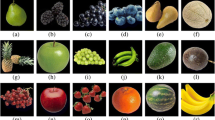Abstract
In this paper, we apply an improved deep convolutional neural network (CNN) in fruit category classification, which is a hotspot in computer vision field. We created an 8-layer deep convolutional neural network, and utilized parametric rectified linear unit to take the place of plain rectified linear unit, and placed dropout layer before each fully-connected layer. Data augmentation was used to help avoid overfitting. Our 8-layer deep convolutional neural network secured an overall accuracy of 95.67%. This proposed 8-layer method performs better than five state-of-the-art methods using traditional machine learning methods and one state-of-the-art CNN method.











Similar content being viewed by others
References
Barushka A et al (2016) Spam filtering using regularized neural networks with rectified linear units. In: 15th International Conference of the Italian Association for Artificial Intelligence (AIIA). Springer Int Publishing Ag, Genova, p 65–75
Benani A (2018) Fruits and vegetables: what is the real benefit? M S-Med Sci 34(4):316–317
Cheng H (2018) Classification of Alzheimer's disease based on eight-layer convolutional neural network with leaky rectified linear unit and max pooling. J Med Syst 42:42
Duggal R, et al (2017) P-TELU : parametric tan hyperbolic linear unit activation for deep neural networks. In: IEEE International Conference on Computer Vision Workshops. IEEE, Venice, p. 974–978
He KM et al (2015) Delving deep into rectifiers: surpassing human-level performance on ImageNet classification. In: IEEE International Conference on Computer Vision (ICCV). IEEE, Santiago, p 1026–1034
Ji G (2014) Fruit classification using computer vision and feedforward neural network. J Food Eng 143:167–177
Jiang Y (2018) Exploring a smart pathological brain detection method on pseudo Zernike moment. Multimedia Tools Appl 77(17):22589–22604
Jiang XH et al (2018) Deep neural networks with elastic rectified linear units for object recognition. Neurocomputing 275:1132–1139
Kamal-Eldin A et al (2018) Classification of date fruit (Phoenix dactylifera, L.) based on chemometric analysis with multivariate approach. Journal of Food Measurement and Characterization 12(2):1020–1027
Kheiralipour K et al (2017) Introducing new shape features for classification of cucumber fruit based on image processing technique and artificial neural networks. J Food Process Eng 40(6):4 Article ID. UNSP e12558
Li YA (2017) Fruit sensing and classification system by fractional fourier entropy and improved hybrid genetic algorithm. In: 5th International Conference on Industrial Application Engineering (IIAE). Kitakyushu, Japan, p 293–299
Liu F et al (2017) Summary on fruit identification methods: a literature review. ESSAEME 119:1629–1633
Lu S (2018) Pathological brain detection in magnetic resonance imaging using combined features and improved extreme learning machines. J Med Imaging Health Inform 8:1486–1490
Lu SY et al (2016) Fruit classification by HPA-SLFN. In: 8th International Conference on Wireless Communications & Signal Processing. IEEE, Yangzhou, p. 11–17
Muhammad K (2017) Image based fruit category classification by 13-layer deep convolutional neural network and data augmentation. Multimed Tools Appl. https://doi.org/10.1007/s11042-017-5243-3
Pan C (2018) Multiple sclerosis identification by convolutional neural network with dropout and parametric ReLU. J Comput Sci 28:1–10
Pan C (2018) Abnormal breast identification by nine-layer convolutional neural network with parametric rectified linear unit and rank-based stochastic pooling. J Comput Sci 27:57–68
Qian P (2018) Cat swarm optimization applied to alcohol use disorder identification. Multimedia Tools Appl 77(17):22875–22896
Qu YW (2013) Interacting multiple Gaussian particle filter. In: Hu T (ed) International conference on artificial intelligence and software engineering. Atlantis Press, Nanjing, pp 62–66
Qu YW et al (2008) Convergence properties of particle filter algorithm. In: Chinese Conference on Pattern Recognition. IEEE, Beijing, p 24–29
Snetkov L et al (2018) An effective model based on Haar wavelet entropy and genetic algorithm for fruit identification. AIP Conf Proc 1955(1):040013
Srivastava N et al (2014) Dropout: a simple way to prevent neural networks from overfitting. J Mach Learn Res 15:1929–1958
Sun J (2018) Preliminary study on angiosperm genus classification by weight decay and combination of most abundant color index with fractional Fourier entropy. Multimed Tools Appl 77(17):22671–22688
Tang C (2018) Twelve-layer deep convolutional neural network with stochastic pooling for tea category classification on GPU platform. Multimed Tools Appl 77(17):22821–22839
Wei G (2010) Color image enhancement based on HVS and PCNN. SCIENCE CHINA Inf Sci 53(10):1963–1976
Wu LN (2008) Improved image filter based on SPCNN. Sci China Ser F-Inf Sci 51(12):2115–2125
Wu LN (2008) Pattern recognition via PCNN and Tsallis entropy. Sensors 8(11):7518–7529
Wu LN (2009) Segment-based coding of color images. Sci China Ser F-Inf Sci 52(6):914–925
Wu L (2011) Recursive structure element decomposition using migration fitness scaling genetic algorithm. In: 2nd International Conference on Swarm Intelligence (ICSI). Springer Verlag, Chongqing, p. 514–521
Wu LN (2011) Bankruptcy prediction by genetic ant colony algorithm. In: International Conference on Computer-aided Material and Engineering. Trans Tech Publications Ltd., Hangzhou, p. 459–463
Wu L (2012) Classification of fruits using computer vision and a multiclass support vector machine. Sensors 12(9):12489–12505
Wu J (2016) Fruit classification by biogeography-based optimization and feedforward neural network. Expert Syst 33(3):239–253
Zhang Z et al (2015) A survey of sparse representation: algorithms and applications. IEEE Access 3:490–530
Zhang Z et al (2017) Discriminative elastic-net regularized linear regression. IEEE Trans Image Process 26(3):1466–1481
Zhao G (2018) Smart pathological brain detection by synthetic minority oversampling technique, extreme learning machine, and Jaya algorithm. Multimed Tools Appl 77(17):22629–22648
Acknowledgements
This paper was funded by Open fund for Jiangsu Key Laboratory of Advanced Manufacturing Technology (HGAMTL-1703), Henan Key Research and Development Project (182102310629), National key research and development plan (2017YFB1103202), Natural Science Foundation of China (61602250).
Author information
Authors and Affiliations
Corresponding authors
Ethics declarations
Conflict of interest
We have no conflicts of interest to disclose with regard to the subject matter of this paper.
Ethical approval
This article does not contain any studies with human participants or animals performed by any of the authors.
Additional information
Publisher’s Note
Springer Nature remains neutral with regard to jurisdictional claims in published maps and institutional affiliations.
Rights and permissions
About this article
Cite this article
Wang, SH., Chen, Y. Fruit category classification via an eight-layer convolutional neural network with parametric rectified linear unit and dropout technique. Multimed Tools Appl 79, 15117–15133 (2020). https://doi.org/10.1007/s11042-018-6661-6
Received:
Revised:
Accepted:
Published:
Issue Date:
DOI: https://doi.org/10.1007/s11042-018-6661-6




